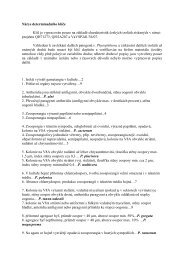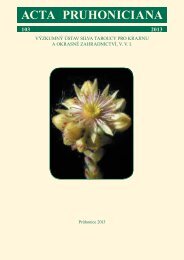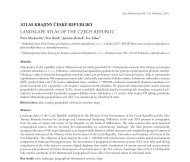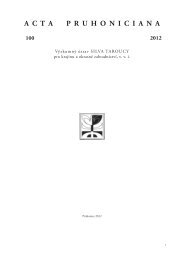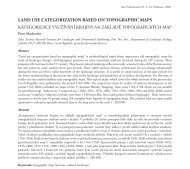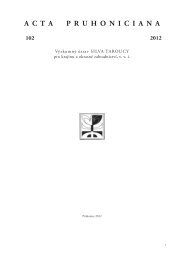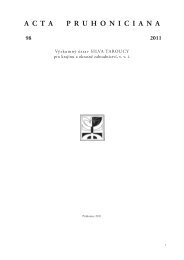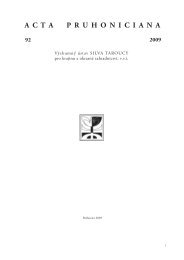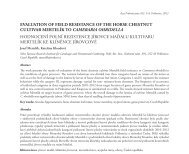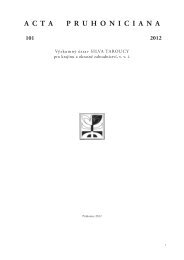Acta 93.indd - Výzkumný ústav Silva Taroucy pro krajinu a okrasné ...
Acta 93.indd - Výzkumný ústav Silva Taroucy pro krajinu a okrasné ...
Acta 93.indd - Výzkumný ústav Silva Taroucy pro krajinu a okrasné ...
You also want an ePaper? Increase the reach of your titles
YUMPU automatically turns print PDFs into web optimized ePapers that Google loves.
heterozygosity of 0.269. Also, Konnert (1993) reported ofexpected heterozygosities for southeastern and southwesternpopulations of silver fir in Bavaria averaging at 0.259 and0.206, respectively. Still other discrepancy concerns deviatedlocation of the Stužica primeval population of adult trees ona dendrogram. This deviation needs to be analyzed further.CONCLUSIONSIn spite of the expectations, we have not been able to <strong>pro</strong>videa conclusive <strong>pro</strong>of that reduction in number of trees inmanaged stands of silver fir is accompanied by a <strong>pro</strong>foundnarrowing of their genetic diversity. Some evidence indicatinglower genetic diversity in managed populations has howeverbeen obtained at the adult trees level in two of the threeanalyzed stands using isoenzyme genetic markers. In orderto obtain a deeper insight on the impact of the managingpractices on genetic composition of silver fir populations, theadditional enzyme markers should be involved into study.Owing to conservative nature of cpDNA exhibiting onlytwo haplotypes in silver fir, the restriction analyses of thismolecule seem to be less perspective in population studiesof the species. Recently published studies indicate that it ismicrosatellites of cpDNA which appear to be more <strong>pro</strong>misingin this respect.AcknowledgementsThe study was financially supported by the VEGA GrantAgency, <strong>pro</strong>ject no. 2/0076/09.REFERENCESBergmann, F. (1991): Causes and consequences of speciesspecificgenetic variation patterns in European forest treespecies: Examples with Norway spruce and silver fir. InMüller-Starck, G. & Ziehe, M. [eds.]: Genetic Variationin European Populations of Forest Trees. Sauerländer’sVerlag, Frankfurt am Main, p. 192–204.Bergmann, F., Gregorius, H.-R., Larsen, J. B. (1990): Levelsof genetic variation in European silver fir (Abies alba): Arethey related to the species` decline? Genetica, vol. 82, p.1–10.Demesure, B., Sodzi, N., Pettit, R. J. (1995): A set of universalprimers for amplification of polymorphic non-codingregions of mitochondrial and chloroplast DNA in plants.Molecular Ecology, vol. 4, p. 129–131.Falinski, J. B. (1986): Vegetation Dynamics in TemperateLowland Primeval Forests. Kluwer Academic Publishers,Dordrecht, 152 p.Hussendörfer, E., Konnert, M., Bergmann, F. (1995):Inheritance and linkage of isozyme variants of silver fir(Abies alba Mill.). Forest Genetics, vol. 2, p. 29–40.Konnert, M., von. (1993): Untersuchungen für die genetische74Variation der Weisstanne (Abies alba Mill.) in Bayern.Allg. Fors- u. Ztg., vol. 164, p. 162–169.Korpeľ, Š. (1989): Pralesy Slovenska. VEDA, Bratislava, 329 s.Korpeľ, Š. (1995): Die Urwälder der Westkarpaten. GustavFisher Verlag, Stuttgart-Jena-New York, 310 p.Larsen, J. B. (1989): Waldbauliche Probleme und Genökologieder Weisstanne (Abies alba Mill.). Allg. Forst-u. Jagdztg.,vol. 160, p. 39–43.Longauer, R. (2001): Genetic variation of European silver fir(Abies alba Mill.) in the Western Carpathians. Journal ofForest Science, vol. 47, p. 429–438.Longauer, R., Paule, L., Andonoski, A. (2003): Geneticdiversity of southern populations of Abies alba Mill. ForestGenetics, vol. 10, p. 1–9.Mejnartowicz, L. (2004): Genetic analysis of silver-firpopulations in the north Carpathian and Sudetenmountains. <strong>Acta</strong> Societatis Botanicorum Poloniae,vol. 73, p. 285–292.Murray, M. G., Thompson, W. F. (1980): Rapid isolationof high molecular weight DNA. Nucleic Acid Research,vol. 8, p. 4231–4235.Müller-Starck, G., Baradat, Ph., Bergmann, F. (1992):Genetic variation within European tree species. NewForests, vol. 6, p. 23–47.Nei, M. (1978): Estimation of average heterozygosity andgenetic distance from a small number of individuals.Genetics, vol. 89, p. 583–590.Parvianen, J., Little, D., Doyle, M., O’Sullivan, A., Kettunen,M., Korhonen, M. (1999): Research in forest reserves andnatural forests in European countries. COST Action E 4,EFI Proc. 16, 299 p.Paule, L., Gömöry, D., Longauer, R., Krajmerová, D. (2001):Patterns of genetic diversity distribution in three mainCentral European montane tree species: Picea abies Karst.,Abies alba Mill. and Fagus sylvatica L. Forestry Journal,vol. 47, p. 153–163.Pitel, J. A., Cheliak, W. M. (1984): Effect of extractionbuffers on characterization of isoenzymes from vegetativetissues of five conifer species: A user’s manual. PetawawaNational Forestry Institute, Canadian Forest Service,Information Report PI-X-34, 64 p.Saniga, M. (1999): Štruktúra, <strong>pro</strong>dukčné a regeneračné<strong>pro</strong>cesy Dobročského pralesa. Technická univerzitaZvolen, 64 s.Saniga, M., Klimaš, V. (2004): Štruktúra, <strong>pro</strong>dukčné <strong>pro</strong>cesya regenerácia pralesa Stužica v 4. lesnom vegetačnomstupni. <strong>Acta</strong> Facultatis Forestalis Zvolen-Slovakia, vol.XLVI, s. 93–104.Silvertown, J. W., Charlesworth, D. (2005): Introduction toPlant Population Biology. Blackwell Science Ltd., Oxford,347 p.Ziegenhagen, B., Kormuťák, A., Schauerte, M., Scholz, F.(1995): Restriction site polymorphism in chloroplast




